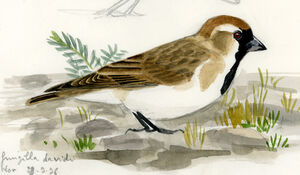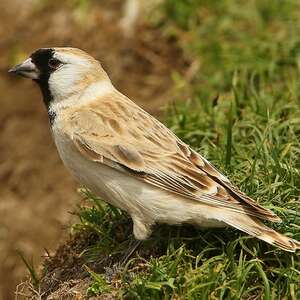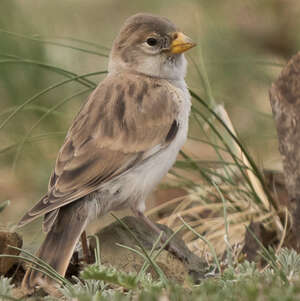Pere David's Snowfinch
Pyrgilauda davidiana - Niverolle de David
Identification
Pere David's Snowfinch is a small bird, cousin of the sparrow. It has a strong and conic beak which is grey, a characteristic head with its black mask completely surrounding the bill (forehead, lores, throat and chin). The eye is black with a half-circle also black in front. The back of the eye is often clear towards the white and goes up to the neck. The cap is brown and this colour extends over the mantle which presents white stripes up to the rump. The primary remiges and the greater-coverts are marked in black, the abdomen is whitish, the chest is light brown close to the colour of the mantle. The legs are black.
There is no dimorphism, the young ones are paler and don't present the black mask of the adults.
A bit of curiosity: the name of this passeridae comes from the Lazarist missionary Father Armand David (born in Espelette, Basque Country, 1826, dead in Paris 1900), eminent zoologist and botanist who discovered the Giant Panda to the West, but also the David's Deer and who published in 1877 The Birds of China.
Subspecific information 2 subspecies
- Pyrgilauda davidiana davidiana (s Mongolia and n China)
- Pyrgilauda davidiana potanini (sc Siberia and e Mongolia)
Foreign names
- Niverolle de David,
- Gorrión de David,
- pardal-mongol,
- Daviderdsperling,
- Pater Davids Sneeuwvink,
- Fringuello alpino di Padre David,
- mongolsnöfink,
- Gobifjellspurv,
- psiarka čiernohrdlá,
- pěnkavák černočelý,
- Lille Snefinke,
- pikkulumivarpunen,
- pardal del pare David,
- śnieżka mongolska,
- Altaja sniedze,
- Монгольский земляной воробей,
- モウコユキスズメ,
- 黑喉雪雀,
- mongolsnöfink,
- 黑喉雪雀,
Voice song and call
Habitat
Behaviour character trait
Dietfeeding habits
Reproduction nesting
Pere David's Snowfinch builds its nest on the ground with dry grass and may use wool found near domestic and wild herds. It is often observed near the burrows of susliks, hamsters, and pikas (small rabbits with loud cries). This coexistence allows them to share the monitoring of predators. The reproduce period is from May to late July, and the brood usually consists of 5 to 6 eggs.
Geographic range
Threats - protection
Sources of information
- IOC World Bird List (v15.1), Gill, F and D Donsker (Eds). 2025-12-07.
- Handbook of the birds of the world Vol.14, josep del Hoyo
- Wikipédia, Wikipedia, The Free Encyclopedia
- BirdLife International, BirdLife International
Other sources of interest
 Specification sheet created on
04/08/2023 by Anne et Gabriel Leboff
Specification sheet created on
04/08/2023 by Anne et Gabriel LeboffTranslation by AI Oiseaux.net
© 1996-2025 Oiseaux.net
- Accipitriformes
- Aegotheliformes
- Anseriformes
- Apodiformes
- Apterygiformes
- Bucerotiformes
- Caprimulgiformes
- Cariamiformes
- Casuariiformes
- Charadriiformes
- Ciconiiformes
- Coliiformes
- Columbiformes
- Coraciiformes
- Cuculiformes
- Eurypygiformes
- Falconiformes
- Galliformes
- Gaviiformes
- Gruiformes
- Leptosomiformes
- Mesitornithiformes
- Musophagiformes
- Nyctibiiformes
- Opisthocomiformes
- Otidiformes
- Passeriformes
- Pelecaniformes
- Phaethontiformes
- Phoenicopteriformes
- Piciformes
- Podargiformes
- Podicipediformes
- Procellariiformes
- Psittaciformes
- Pterocliformes
- Rheiformes
- Sphenisciformes
- Steatornithiformes
- Strigiformes
- Struthioniformes
- Suliformes
- Tinamiformes
- Trogoniformes
















